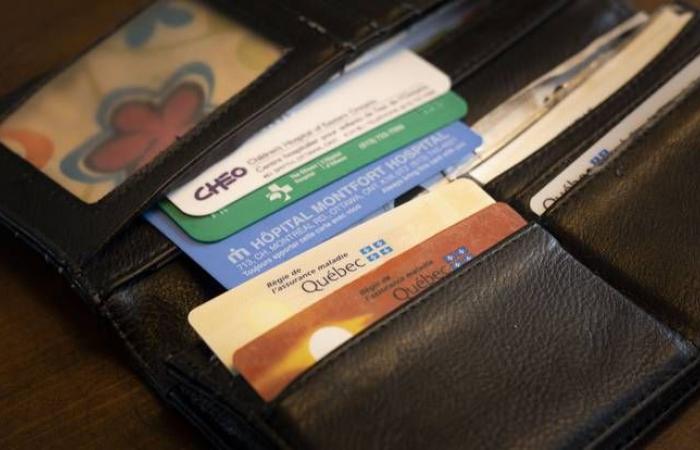The Coops de l’information obtained a lot of data from the Régie de l’assurance maladie du Québec (RAMQ) concerning the consumption of care in the neighbouring province, both for the amounts reimbursed to establishments and those paid to doctors.
For the year 2023, payments made to Ontario hospitals for care provided to some 93,000 Quebec patients currently total $188 million, a 14% increase over the previous year. The final amount could be slightly higher, since institutions have three years to submit an invoice.
The vast majority of Ontario hospitals receiving reimbursements from Quebec are located in the border area, in Ottawa or elsewhere in Eastern Ontario.
The Ottawa Hospital, which has three campuses, for example, received $47 million from the RAMQ for services provided to Quebec citizens in 2023. The Children’s Hospital of Eastern Ontario, for its part, provided $34 million in care to young Quebecers last year.
The Ottawa Hospital treats many Quebecers each year. (Simon Séguin-Bertrand/Le Droit Archives)
For all of Ottawa’s hospitals, the amounts billed to Quebec come mostly from services provided to residents of Outaouais, who only have to cross one bridge to reach the federal capital.
The most commonly used specialized care on the Ontario shore is pediatrics, cardiology, ophthalmology and obstetrics-gynecology. Each year, nearly a third of Outaouais residents who give birth do so on Ontario soil.
The RAMQ specifies that “the amounts reimbursed are always the amounts in effect in Quebec, and not those in Ontario.”
“An old trend”
Damien Contandriopoulos, a professor at the University of Victoria’s School of Nursing, points out that the consumption of care in Ontario by Quebecers is “an old trend.”
Damien Contandriopoulos is a professor in the School of Nursing at the University of Victoria. (University of Victoria)
The main factor explaining this situation is obviously geographic. “There are more rural areas in Quebec that are close to more urbanized areas in Ontario, so for many people, the closest hospital is in Ontario,” notes Mr. Contandriopoulos.
The professor recalls that “portability” is one of the five principles of the Canadian system, which means that citizens “are within their rights” to seek health care in any province or territory.
The Ministry of Health notes for its part that the proximity of certain regions to Ontario exposes them “to certain particular challenges, particularly with regard to the situation of retention and attraction of the workforce.” “The government takes the situation seriously and is implementing various measures to ensure that quality care can be provided within the required timeframes,” the authorities nevertheless state.
Hawkesbury General Hospital in Eastern Ontario. (Archives Le Droit)
Direction Hawkesbury
In Hawkesbury, in Eastern Ontario, the local hospital received nearly 42 million from the RAMQ for care provided during the year 2023.
It is the residents of the Laurentians who most often cross the interprovincial border to obtain hospital care – they are responsible for more than 40% of the amounts reimbursed by the RAMQ.
The inhabitants of Montérégie represent almost a third of the bill, while those of Outaouais are responsible for 15% of the amounts paid by the Quebec government to the Hawkesbury General Hospital.
In 2015, former Health Minister Gaétan Barrette said that Quebec found itself funding renovations and expansion of the Hawkesbury hospital centre because of the large number of patients crossing the Ottawa River to receive treatment there.
“Does it matter whether people go one way or the other? Not necessarily. […] This allows Quebec to have care for its population by relying on the success of its neighbors.”
— Damien Contandriopoulos
The office of Health Minister Christian Dubé assures that they want to “improve access to care for Quebecers.” The office specifies in particular that in the short term, the public network is strengthened by the establishment of the flying team for regions where the situation is more critical “and by bringing thousands of people from private agencies to our network.”
The government also emphasizes that “there was a major delay to catch up on in terms of investments in our health infrastructure” and that it has decided to invest “massively”, among others in Outaouais, the Laurentians and Montérégie. “We know that in the medium and long term, these modern infrastructures will make it possible to better meet the needs of the population and attract more staff,” added Minister Dubé’s office.
Professional services
In addition to the amounts reimbursed to Ontario hospitals, the RAMQ also pays to doctors for “professional services” provided to Quebec residents. In this regard, the bill for 2023 reached $38 million – a decrease of approximately $500,000 compared to the previous year.
By combining these amounts paid for services provided by doctors in Ontario with those reimbursed for care received by Quebecers in hospitals in the neighbouring province, the bill comes to almost $226 million for the year 2023.
Mr. Contandriopoulos indicates that “for hospital components, normally, there are not too many problems” when a Canadian resident is treated elsewhere than in his province or territory. Where it gets complicated is on the side of physician remuneration. “A lot of physicians will be reluctant to accept the health card of another province,” he notes.
The paperwork to be completed and the differences in rates in force from one territory to another thus encourage some doctors to charge patients directly. The latter must then take steps with the competent authorities in order to obtain a reimbursement – sometimes partial – of the sums paid.
In 2022, nearly 10,000 Outaouais residents were followed by an Ontario family doctor registered with the RAMQ. This data excludes doctors who bill patients directly for services provided.
The special case of the Outaouais
Outaouais’ dependence on Ontario’s health network is not new. Despite the development of various repatriation plans over the decades, reimbursements made by the RAMQ for care provided in Ottawa hospitals to Outaouais residents reached a new high last year, at $112.6 million. This is a 15% increase compared to 2022.
Damien Contandriopoulos explains that “the Outaouais, in terms of hospitals, is probably one of the worst places in Quebec.” He also recalls that Robert Salois, who was health and wellness commissioner from 2006 to 2016, was very critical of the Outaouais health network. “And since then, it hasn’t improved,” notes Mr. Contandriopoulos.
Will the Outaouais population’s dependence on the Ontario health network ever diminish? “It will remain asymmetrical as long as the health system remains so asymmetrical,” responds Damien Contandriopoulos. […] The day the trend reverses, it will mean that the Outaouais will have pulled itself out of the hole.”
The reverse is much less frequent.
The consumption of health care in Ontario by Quebec residents is – by far – higher than what the Ontario government must pay for services provided to its citizens in the health network of La Belle Province.
For the 2022-2023 fiscal year, the bill for hospital services received in Quebec by residents from elsewhere in Canada was limited to $51.4 million. This is three and a half times less than the amounts paid by La Belle Province for Quebecers treated in hospitals in other provinces or territories.
For Damien Contandriopoulos, “what explains the fact that it is asymmetrical is that access to care has always been easier in Ontario.” Even if the Ontario network “is not perfect” and it also faces challenges, “all the statistics indicate much easier access to care” in the neighboring province, he explains.






